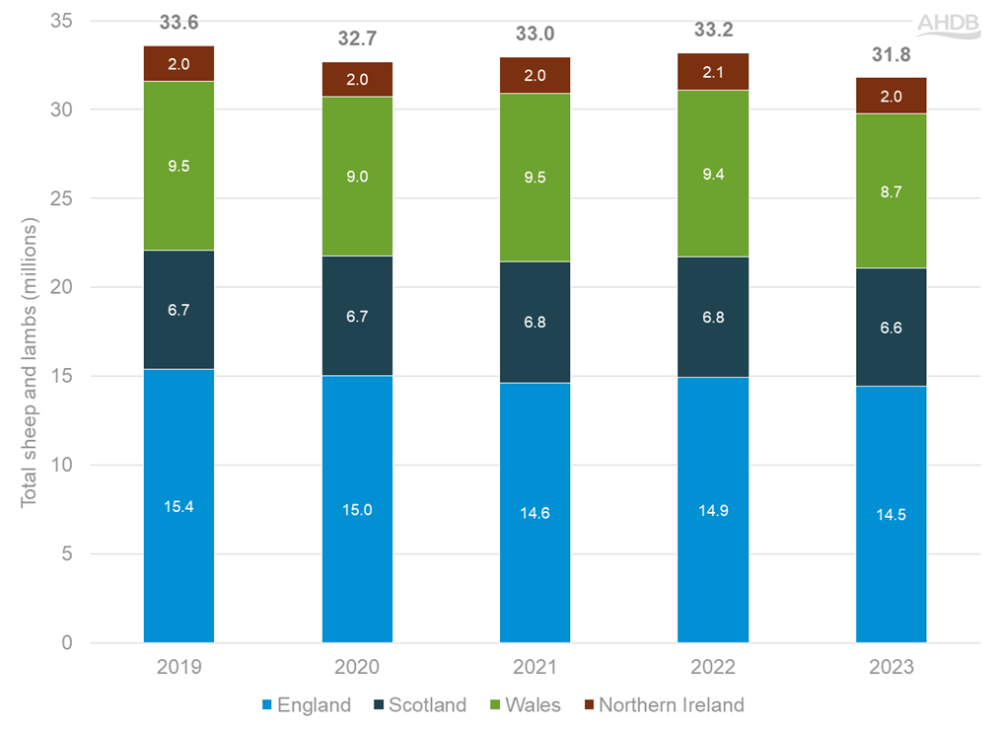Sheep population: Defra’s June census shows continued shrinking of the UK sheep flock
Thursday, 4 January 2024
Key points
- UK sheep flock stood at 31.8 million head as of 1 June 2023, 4% smaller versus a year ago
- Female breeding flock contracted by 2.4% year on year to 15.4 million
- 6% reduction in number of lambs aged under 1 year old, supporting reports of a delayed lamb crop in 2023/24
- Increased number of old season lambs, reflective of a greater carry-over into 2023 and later sales
UK sheep population at its lowest in 12 years
Defra census figures recorded the UK sheep flock at 31.8 million head as of 1 June 2023, down 4.1% on the previous year. This is the lowest recorded population since 2011.
The female breeding flock totalled 15.4 million head, a 2.4% decline compared to 2022. This was driven by a 219,000 (-1.7%) reduction in the number of ewes kept for further breeding or slaughter compared to the 2022 count. Meanwhile, the number of ewes for first time breeding was down 168,000 (-6.1%) on the year. These reductions may be linked to the high costs of feed and other inputs, alongside market uncertainty, causing farmers to scale back production.
The greatest reduction was seen in the number of lambs aged under 1 year, which was down 998,000 head (6.1%) year-on-year to stand at 15.5 million. This would suggest either a smaller or delayed lamb crop for this season, reflective of a relatively wet and cold spring and industry reports of variable scanning rates.
Ram numbers saw a more subtle decline, down 0.9% to stand at 387,000 head. This continues a general trend of long-term contraction, in tandem with the shrinking breeding flock. Improvements in ram productivity and increasing focus on bettering genetics through selective breeding are also likely contributors to this trend.
Conversely, other sheep and lambs aged 1 year and over increased in number, up 18,000 head (+3.7%) to stand at 517,000 in June. We saw a larger carry-over of old season lambs into 2023 likely due to poor weather and high feed costs. This was reflected in last summer’s auction market data, with a higher number of old season lambs (hoggets) marketed later in the season compared to previous years.
Welsh flock sees steepest contraction
Comparing across the nations, the greatest contraction was seen in Wales, down 195,000 head (-4.2%) in the female breeding flock year-on-year. England and Scotland saw 1.6% and 1.7% declines, respectively, in breeding female sheep populations.
UK sheep population on 1 June by nation

Source: Defra
Looking ahead
Looking forward to 2024, the sheep population and production may continue to contract, with fewer breeding ewes to produce next year’s lamb crop. Of course, conditions at tupping and lambing will also influence this picture. Our soon to be released market outlook will explore predictions for 2024 in greater detail.

Sign up for regular updates
You can subscribe to receive Beef and Lamb market news straight to your inbox. Simply fill in your contact details on our online form.
While AHDB seeks to ensure that the information contained on this webpage is accurate at the time of publication, no warranty is given in respect of the information and data provided. You are responsible for how you use the information. To the maximum extent permitted by law, AHDB accepts no liability for loss, damage or injury howsoever caused or suffered (including that caused by negligence) directly or indirectly in relation to the information or data provided in this publication.
All intellectual property rights in the information and data on this webpage belong to or are licensed by AHDB. You are authorised to use such information for your internal business purposes only and you must not provide this information to any other third parties, including further publication of the information, or for commercial gain in any way whatsoever without the prior written permission of AHDB for each third party disclosure, publication or commercial arrangement. For more information, please see our Terms of Use and Privacy Notice or contact the Director of Corporate Affairs at info@ahdb.org.uk © Agriculture and Horticulture Development Board. All rights reserved.

